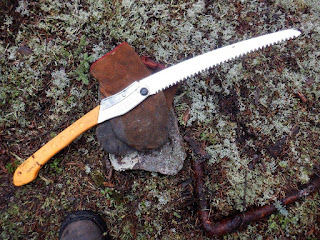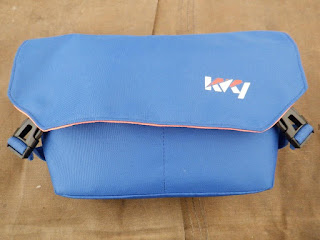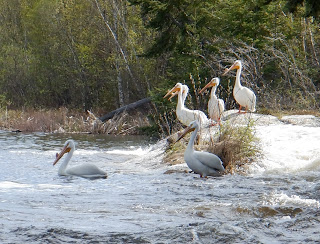Up at 03:00, 5°C, I start a fire to warm up and heat some water to accompany a cold breakfast. Note the pile of ashes dumped from the stove into the fireplace; they and the fire will be doused well with water before leaving.
Heading down the lake from camp 1.
As the lake narrows near its exit, I approach the portage which goes past a trapper's "cabin".
The lower end of the first portage, 100 metres long. With high water levels, I am able to progressively push the canoe out as it gets loaded so as to avoid getting water over my boot tops.
Winding through a thick growth of last year's cattails. Coming back through them when I return in the autumn will not likely be as easy.
Paddling down an unnamed lake to the next portage.
The lower end of the second portage at the bottom of a steep hill. Because of the elevated water level, I am able to take a shorter 60 metre trail instead of the 100 metre one I will probably have to use on my return.
Moving on down a meandering creek through more cattails to the next lake.
Reaching the outlet of the lake to the third 100 metre portage which bypasses rapids ending in a waterfall that is a very full, fast and noisy cataract. The falls runs over the crossways rock ledge below in two places.
June 4 has been a long day and I erect the nylon tent for the night. The next day I put up the canvas Tent, thinking that the cold wet weather will resume.
My first fish, a northern pike, along with a fresh salad for supper (young birch leaves, alder catkins, dandelion greens and flowers).
American white pelicans keep me company for the duration of my stay.
A bald eagle often sits at the base of the falls overlooking the pelicans.
**********************
Summary:
On the second portage I fall hard on my right arm and shoulder with a loud crack, making for sore lifting, paddling and even sleeping. A bald eagle and up to 17 pelicans keep me company. Catch my first fish for supper. Travel 14 km, with three portages (60, 100, 100 metres), a long day.
June 4:
Waking to a cold morning, in addition to two shirts, I don hat and bandana around my neck. After packing sleep gear, I start a warming fire. This year, instead of a short T-shirt under a heavier long-sleeved shirt I am wearing a light long-sleeved button-up shirt with a collar. This shirt will help protect my arms from scratches and burns and the collar can be turned up against the sun. The heavy shirt, the same style as the light one, is extra-large (XL) size to better cover my wrists and waist and the sleeves slip on my arms without undoing the cuff buttons. The light shirts are "dress" ones I used when still working but I have to undo the cuffs to get them on which is a pain, and the tails tend to come out of my jeans; next year I will buy XL size. No fashion statement from me. Unfortunately, manufacturers are adding spandex to new shirts which make them hotter. Thank goodness I can still buy 100% cotton jeans; I have used jeans with spandex and they are uncomfortably clingy and hot. Back to the Tent, I pack all gear and carry to the landing to load the canoe before eating breakfast. Leaving at 07:30, 4½ hours after rising, is much too long but that will improve as I get into a routine. As I paddle to the first portage, I pass several ducks madly quacking as they lift off. Water levels are high after a big snowfall winter, and the creek flowing past the portage is deep and fast. I momentarily consider running it, but there are boulders midstream and a big drop over an old beaver dam. The first 100 metre portage is routine, the usual grunt work.
Moving on to the second 100 metre portage I see that it would be necessary to wade while loading the canoe at the lower end. So, I check the shorter 60 metre trail down a steep rock hill where I will be able to load the canoe without getting wet. After placing some beaver cut poles to allow me to skid the canoe across a rock at water's edge at the shorter portage, I relaunch to paddle another 20 metres closer, turning around to back stern-first to shore. From my journal: "Should have cut out some of the willows beside the canoe (as I did after the fact). While stepping out of the canoe with a pack I tripped over a willow branch and landed hard on my right arm and shoulder. Aie! Heard a loud crack and my first thought was a broken bone. Aie! I was and am sore but everything seems to move OK, just painfully. Perhaps the crack was my body breaking branches? Then I got out pruners and saw and trimmed the offending branches plus several alder and birch across the trail on shore. Too late! Aie! Was able to hoist packs and barrels with some difficulty as my arm rebelled. Especially because of my shoulder I pulled the canoe down the trail, but probably would have anyway as it is quite steep. Trail is relatively smooth on rock and grass. On my way again was concerned about paddling but managed OK although sore, just sucked it up. Consider myself lucky. Older self should have known better. Lesson learned! Was a double whammy ... not clearing the brush, but even more problematic my habit of carrying heavy gear in or out of the canoe while stepping over the gunwale. Should lift gear in or out and then step over. A bad habit eventually catches up to you." Even after this accident I catch myself, a creature of habit, still stepping over the gunwale while hoisting a pack. Aie!
The canoe must be loaded from the stern end while the canoe floats in the water out from shore; this is always more difficult than if canoe tied at both ends along shore as I have to place gear into the tippy canoe then carry forward. Because the lower end of the steep trail enters directly into the lake, I must set the barrels directly on the muddy bottom, twisting the barrel back and forth until level enough to stay standing; then I can hoist one at a time into the stern and walk it to its location towards the bow. I paddle down the winding creek thickly bordered by cattails and other reeds. The north wind has been picking up so when I hit the next lake it is a direct headwind. Hungry for lunch, I pull towards the lee of a small rock point for lunch. Attempting to back in along the rockface, fallen trees in the water and the strong wind say otherwise so I have to make an ungraceful long curving exit into the lake again to paddle bow first along the shore facing the direction I have come. I find paddling on the right side of the canoe is more painful than the left, so am thankful that I fell on my right shoulder, even though that is my dominant arm, as I usually paddle mostly on the left side.
Continuing on I paddle a less direct route to the west side of a long island hoping to get some relief from the wind, but to no avail. Reaching the outlet of this lake, which tumbles down a short set of rapids over a waterfall, I portage all the gear down the third 100 metre trail and then another 50 metres to the area where I will set up the nylon tent. The water pouring into the next lake is quite high, fast and noisy, but I will be camped far enough away that the sound should be less disturbing for sleep. Not sure if I can hoist the canoe I manage after two tries to shoulder it, definitely depending more on my left side, the last test for my continued journey. I would hate to have to ask Jeanette to charter a float plane to fly me out so soon after starting. After all gear at the campsite, I initiate the "SPOT™ Satellite GPS Messenger" at 17:15 to notify my contacts the location of my second campsite. I have travelled 14 km including three portages (60, 100 and 100 metres). The supper fire is a cold spot, very exposed to the wind beside the shore; the meal is my hungry go-to meal of macaroni and cheese. Weary, tired and sore shoulder, to bed by 21:00. Concerned that my shoulder would hamper sleep, I can lay on either side but putting weight on the right side arm or removing the right arm shirt sleeve is uncomfortable and makes me pause to figure out how to do it less painfully. I sleep okay, but have leg cramps several times when up to pee, dehydrated and over-used leg muscles, not drinking enough water during the day. A reminder to drink more, especially since I have the convenience of a LifeStraw® water filter.
June 5:
Sleeping in, I arise by 07:15. It is a cold 8°C so I wear two shirts plus a fleece sweater, especially needed at the fireplace which is exposed to a brisk wind. After breakfast, I erect the canvas Tent beside the nylon tent, then transfer all the gear and pack the nylon tent. I miscalculate the height of the vertical support poles for the Tent, not allowing for the sag in the extra long length of rope needed to reach an appropriate anchor tree. Aie! So then have to fell and limb two more spruce trees at a distance from camp in the bush but will use the spruce boughs for the Tent doorway. Chilled because I removed the heavy shirt and fleece for supper when I was too warm, I get into the sleeping bag right away at bedtime. I sleep to the constant rumble of the rapids and falls. Before bedtime I kill two mosquitoes in the Tent.
June 6:
The day starts off cool at 8°C but rises to 18°C in the afternoon with sunny mostly blue sky and some white cumulus, light wind, gorgeous weather. I bake a bannock in front of the fire, which works much better for the new recipe than on the stove, but still takes finesse to mix, bake and turn over without crumbling. A woodpecker hammers away nearby; I hear it every day while here. There are two pelicans on the rock shelf below the falls, reminding me to do some fishing for supper. I catch my first fish of the season from shore, an 18" pike, after losing a bigger one just as I get it to the bank. I try for another with five different lures in three spots from shore with no bites. From my journal: "Hooked a tree branch once. On retrieving it, snagged a different branch. Got a forked stick to pull the branch close enough to reach ... and the lure fell out on its own. Saw one walleye checking out the lure right at the shore. Will canoe to the ledge below the falls tomorrow to fish." After lunch there are five pelicans on the ledge at the falls, a bit later eight; they are getting more used to me and not swimming so far away when they see me. Supper is fish chowder accompanied by a fresh salad of birch leaves, alder catkins and dandelion flowers and greens ... mmm good. I am glad that I only caught one fish, plenty for me today, not super hungry at this stage of the trip. By early evening there are 17 pelicans; I do not see them flying in although they could be landing out of sight; they are fearless swimmers and could also be floating down the rapids and over the falls. I do notice some pelicans in the rapids between the falls and the ledge, not bothered by the turbulent waves. There are two red-necked grebes bobbing in and under the water at the lower end of the rapids. Again at bedtime I kill two mosquitoes. Warmer tonight, I start off in the fleece shell, but by morning I am in the sleeping bag, hood drawn tight against the cold. My right shoulder is bothering me more as I try to find a comfortable sleeping position no matter which side.
June 7:
Another cool night, 6°C when I arise at 06:30, so don fleece sweater. There are a few early mosquitoes when I start a small fire to heat water with a cold breakfast; as usual they do not show up in numbers until it reaches 10°C. It is a calm day, reaching 19°C in the afternoon with blue sky and white clouds. Thirteen pelicans retreat from the ledge at the falls when they see me fetching water. From my journal: "They are all huddled on the far side of the bay about 500 metres away, plotting whether to return. Sorry to spoil their spot but I'm canoeing to the ledge to fish after breakfast. They all paddle away when I arrive, a bald eagle overlooking the scene flying off. Try fishing to no avail! Aie! Had high hopes for walleye. Was planning to stay another day, but will move on tomorrow, weather permitting. My woodpecker is pecking again in the same area but haven't seen it yet; assume it is probably a hairy, or even a three-toed, woodpecker, not loud enough for a pileated one." Walking down the lake shore, there are five spots suitable to fish from and I catch a 21" pike from the last one for supper. I have a hot shower mid-afternoon which feels great; a few mosquitoes are biting. I prepack as much as possible to move on tomorrow, then to bed by 20:30 and soon into the sleeping bag to keep warm.


































































